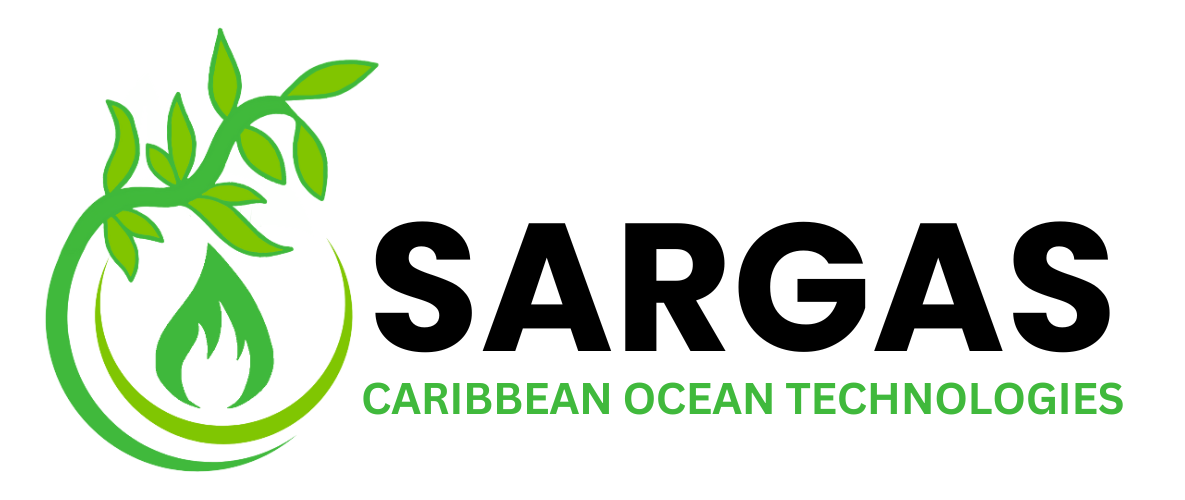Have you ever walked along a beach covered in thick mats of seaweed and wondered why it’s there? Why has Sargassum, once a natural part of the marine ecosystem, become an overwhelming problem for coastal communities? And most importantly, how can we turn this challenge into a solution?
Turning crisis into opportunity
In recent years, coastal communities across the Atlantic have faced a growing challenge: the increasing influx of Sargassum seaweed. This phenomenon, driven by a combination of climate change, ocean currents, and nutrient pollution, has had significant ecological, economic, and social consequences. At SarGas Ltd, we recognize the urgency of this issue and are committed to developing sustainable solutions that mitigate its impact while creating value from this abundant natural resource.
The environmental consequences
Sargassum, a type of brown seaweed, plays an essential role in marine ecosystems by providing habitat for various species. However, when excessive amounts reach shorelines, they disrupt coastal environments. One of the biggest concerns with excessive Sargassum accumulation is its decomposition. In anaerobic conditions, such as when large amounts of seaweed pile up and are deprived of oxygen, Sargassum releases methane—a highly potent greenhouse gas that contributes significantly to climate change. This adds to the urgency of finding sustainable solutions for its management and utilization.
The decomposing seaweed also releases hydrogen sulfide, a gas that produces an unpleasant odor and can pose health risks. Additionally, the dense mats of Sargassum prevent sea turtles from nesting and disrupt marine tourism, a critical industry for many coastal economies. The excessive accumulation of Sargassum leads to severe environmental problems:
- Methane emissions: Methane, a 30 times more potent greenhouse gas compared to carbon dioxide, is released to the atmosphere.
- Marine ecosystem disruption: The overgrowth of Sargassum depletes oxygen levels in water, leading to fish kills and damage to coral reefs.
- Coastal erosion and biodiversity loss: Sargassum smothers beaches, preventing natural sand movement and harming coastal vegetation.
- Water quality issues: As it decomposes, Sargassum releases organic matter that contributes to harmful algal blooms, further degrading water quality.
Why SarGas is taking action
At SarGas Ltd, we see this crisis as an opportunity to innovate and turn a problem into a resource. By addressing methane emissions from decomposing Sargassum, we not only help mitigate climate change but also create valuable products from this abundant natural material. In times of uncertainty, rising energy prices, and global conflicts, achieving energy independence has never been more critical. Harnessing renewable resources like Sargassum allows for more resilient and self-sufficient energy systems, reducing reliance on fossil fuels and external supply chains.
Our initiatives focus on:
- Renewable energy and biogas production: By converting Sargassum into biogas and further valorize it into electricity, we create a sustainable energy source while reducing dependency on fossil fuels.
- Agricultural and industrial applications: The rich nutrient profile of Sargassum makes it an excellent organic fertilizer, which is produced in small island nations with limited access to fertilizers.
- Sustainable harvesting and processing: We are using eco-friendly methods to collect and repurpose Sargassum, ensuring minimal disruption to marine life.
A vision for the future
Addressing the Sargassum issue requires a collaborative effort between governments, private enterprises, and local communities. By leveraging innovation and sustainable practices, SarGas aim to transform Sargassum from an environmental burden into a valuable resource that benefits both people and the planet.
SarGas’ mission is to drive positive change through sustainable solutions. The challenges posed by Sargassum are significant, but with the right approach, they also present opportunities to create a more resilient and sustainable future. We invite investors, farmers, NGOs, partners and other stakeholders to join us in our commitment to environmental stewardship and resource innovation.
Together, we can turn the tide on Sargassum’s impact and harness its potential for a better tomorrow.



